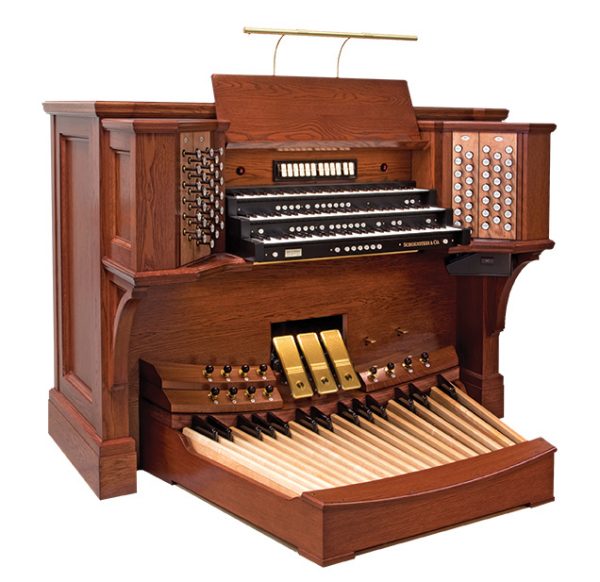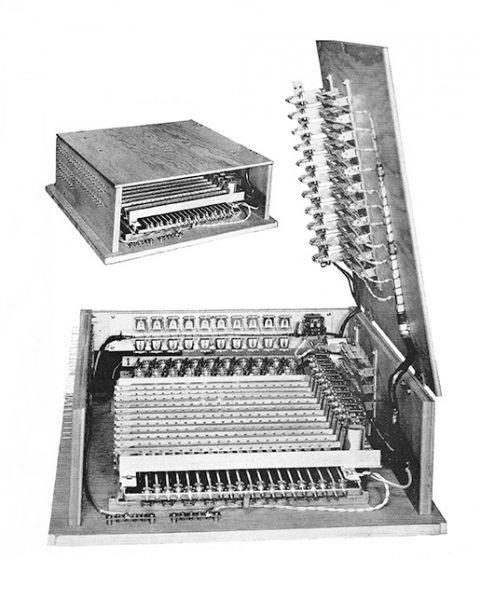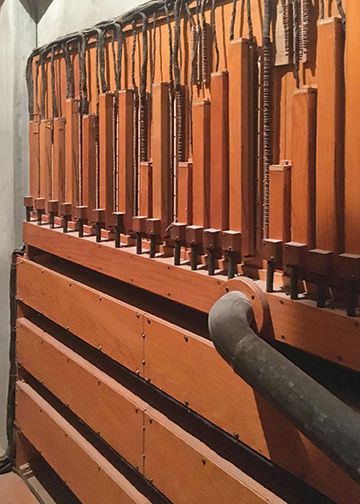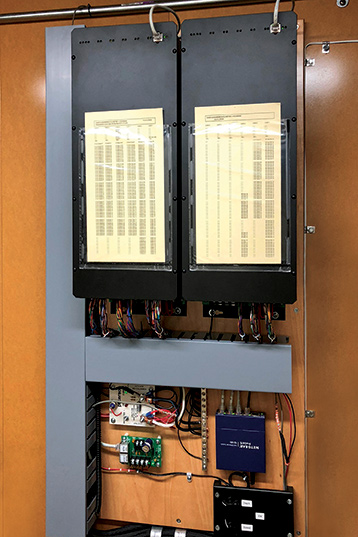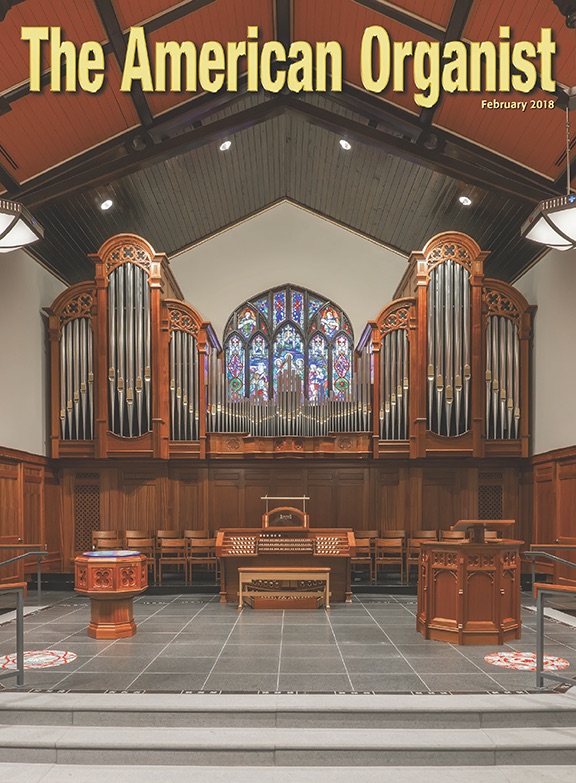
Shandon Presbyterian Church
Columbia, South Carolina
Lewtak Pipe Organ Builders
by Tomasz Lewtak
View an enlarged cover
View the Stop List
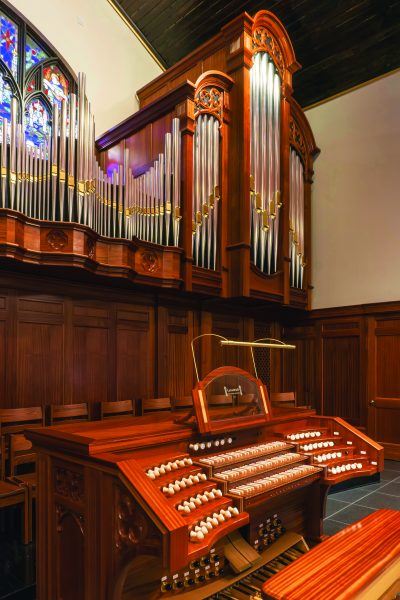
Building a three-manual tracker instrument is exciting and challenging. In the case of Shandon Presbyterian Church, the greatest predicament stemmed from the limited space in which the sizable organ is placed. All 3,075 pipes, including the full-length 16’´reed and open 16′ Contre Viole, had to be fitted within a 135- square-foot area. It nearly put us beyond our comfort zone, as we realize the importance of accessibility to all pipes and internal components. The solution came with many hours of creative design. The end result is tight, but comfortable.
Rather than provide obvious information about our quality materials, excellent construction, and painstaking attention to the smallest details, we focus our thoughts on one aspect often underappreciated and treated as secondary— tuning and temperament.
What determines the temperament for a new organ, or any instrument for that matter? Perhaps the simple answer is personal taste, but surely there are other factors, such as style and character of the instrument, its future role and functionality. We have no intention of arguing the superiority of one tuning over another. After all, what is beautiful to some may be unattractive to others! In our quest for the best temperament we settled on universality as the most important factor. Equal temperament lacks color and variation of different keys. It can be compared to a gray paint with which all music will be treated, well . . . equally! What a loss for repertoire composed in different keys! The Shandon organ is tuned according to a formula from 1724, developed by the German theorist and composer Johann Georg Neidhardt. We stumbled upon this temperament when the consultant for our organ in Denmark requested it. We experienced a total aural surprise in the most positive way—it worked in an incredibly subtle way, giving various keys their unique individuality without being perceived as harsh or, as it is in cases of many other unequal temperaments, unusable. In fact, it made the organ sound sweet and playful. To the average listener there are no unpleasant surprises associated with tonality. Organists find it perfectly usable for virtually all of the literature.
Many people contributed to this enormous project. The person who deserves the highest recognition is consultant Timothy Belk. His energy, enthusiasm, kindness, and perseverance made this undertaking a reality. We will remain forever grateful.
Tomasz Lewtak is president of Lewtak Pipe Organ Builders.
For further information regarding the work of Lewtak Pipe Organ Builders, visit lewtak.com.
Photography: Mateusz Littwin
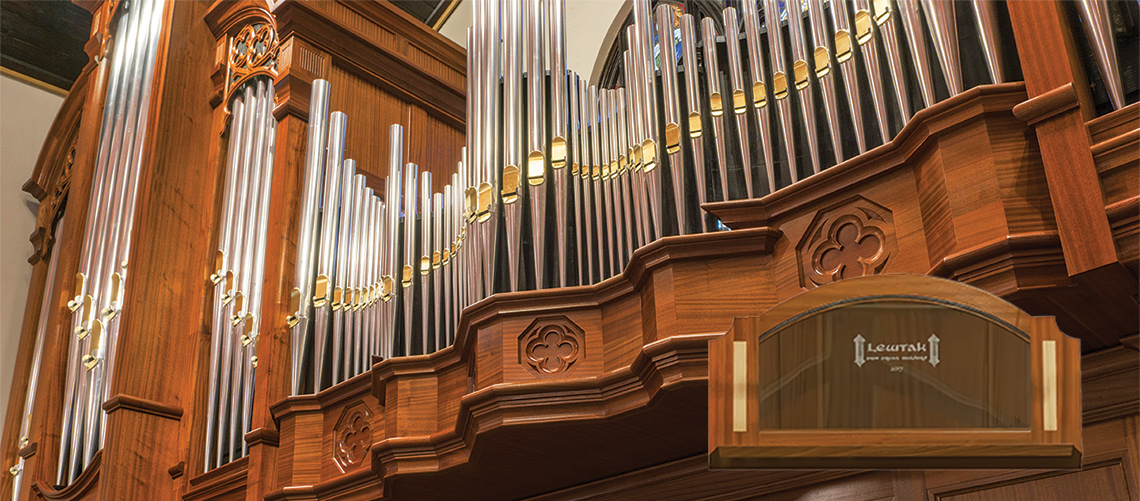
Located in the heart of Columbia, South Carolina, Shandon Presbyterian Church has been affiliated with the Presbyterian Church USA since 1916. A worshiping community of nearly 900 parishioners celebrated their centennial with the preservation of the neo-Gothic-style sanctuary interior and new pipe organ.
As specified by acoustic design consultant Dana Kirkegaard, the 39-foot ceiling was reinforced with thick wooden decking to better enhance the spoken and sung Word. Its adobe color is accented with gold-colored molding. With once-fashionable carpeting removed, the original tupelo wood flooring was restored to a rich luster. Hardwood pews were stripped of thick cushions and refinished to their original color. Stained-glass windows, from the studio of George Hardy Payne of Paterson, New Jersey, were meticulously cleaned revealing the artistry and splendor of artist Per Bergethon. Crenshaw Lighting of Floyd, Virginia, dramatically improved overall lighting with custom fabricated bronze LED fixtures.
The south transept houses original chancel furnishings faithfully restored and dating from the 1920s. Named for its central window, The Sower’s Chapel is an intimate setting for smaller memorial, Taizé, and wedding services.
An inviting narthex welcomes visitors and worshipers alike. A blue ceiling reminds us of the promise of a new day.
The original M.P. Möller organ (Opus 6626, 1938), and its 1958 and 1975 modest additions by the original builder were removed and the chancel expanded to maximize flexibility within the contexts of worship and concert alike. New chancel furnishings, designed by liturgical consultant Terry Byrd Eason of Chapel Hill, North Carolina, and crafted of exotic sapele wood by Lewtak Pipe Organ Builders, are seamlessly wed to the organ case design. Its speaking facade is comprised of tin principal pipes with gilded mouths of 24-carat gold leaf.
Tuned in a slightly modified temperament, the organ, leaning toward the romantic, is well suited to all periods. Manual divisions offer a rich singing fond d’orgue, punctuated with orchestral color and pungent chorus reeds, mutations, and complementing mixtures. Comprised of 47 stops and 59 ranks, the new organ pays homage to the old with the subbass, violone, and clarinet retained from the original instrument. Walker Technical provided judicious use of the usual 32′ digital stops, which serve well in the small space. The use of carbon fiber trackers offers the organist tremendous touch control while electric stop action with Heuss Orgelteile’s virtually unlimited memory and solid-state expression provide ease of playing. A French terrace console design ensures visibility of the choir.
Shandon enjoys a traditional worship and music ministry comprised of usual singing and ringing choirs for all ages, and an admirable concert series. The organ remains a central voice in this intentional focus. The organ selection committee struggled with a desire to commission a mechanical- action organ of three manuals despite constraints defined by a central window. A church musician and organist, North Carolina-based organbuilder Tomasz Lewtak brought a wealth of practical and professional knowledge. His contagious passion, realized in the aural and visual beauty of the organ, is the crown jewel of the centennial effort.
Timothy J. Belk
Church Administrator
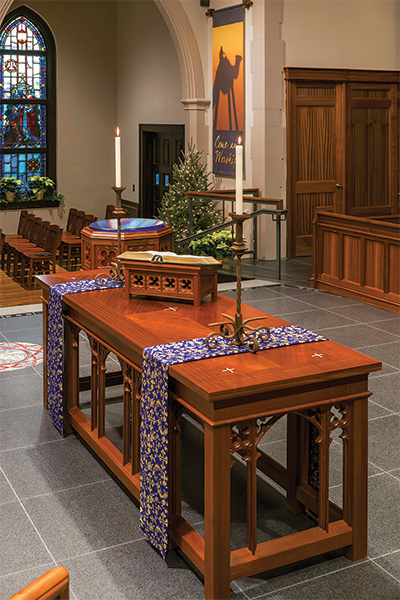
Our firm was invited to work with Shandon Presbyterian Church several years before the organbuilder was finally selected. The church, before renovation, suffered from the typical constricted choir area behind a narrow stage-like rostrum pulpit, the communion table down on the nave floor level with very poor visibility, and very dry acoustics that did not well support hymn singing and traditional music. By way of an extensive design process with a church committee, a very flexible single-level chancel platform plan, which strategically fills much of the “crossing” area defined by the transept seating, is large enough to maximize the possibilities for many kinds of liturgical and musical uses. New flexible principal furnishings (communion table, pulpit, and font) were designed to relate to the simple and restrained Gothic characteristics of the church building. New ministers’ chairs were developed to permit masking of the new organ console when desired, or re-spaced or removed to allow variable or full visibility to the fixed console location. These chairs together with movable choir modesty screens permit the choir area to expand onto the spacious main platform when a larger choir or orchestra is needed. Likewise, the choir area can be reduced to maximize the open space available on the chancel platform.
The new choir and organ area remains on the central axis, but with an expanded width and depth permitted by the removal of the large proscenium arch that defined the old constrained choir loft and side-opening organ chambers. This reconstruction of the chancel end of the church was coordinated with replacement of the old lightweight wooden dropped ceiling with a much heavier wooden ceiling that maintains the previous ceiling form and retains the ornamental wooden arches that conceal the main steel structure. The new ceiling was extended solidly back over the reconfigured organ and choir area so that these key elements for musical leadership were now in the same acoustic space as the gathered congregation.
The organ selection committee very much wanted a mechanical-action organ. Removal of the large central window was considered by some organbuilder proposals, but that was met with much resistance from the congregation as might be expected. The large organ cases that now flank the retained window in the widened choir area were developed by Douglas Abbott of Abbott Designs and, wisely, are broken into three parts with the smaller part of each case placed closest to the window so that the window remains the focal point of the chancel. The Eason firm also developed the design for the pipe shades that work with the rounded forms of the top of the organ cases but introduce a subtle Tudor Gothic shape to the largest pipe towers to relate to the room architecture, the central window, and the new chancel furnishings.
Terry Byrd Eason
Terry Byrd Eason Design
Liturgical Design Consultant
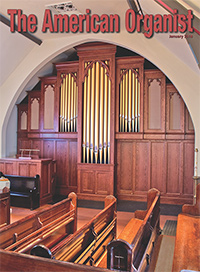 Key to Pipe at the Speed of Light
Key to Pipe at the Speed of Light